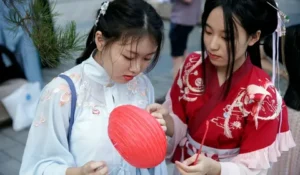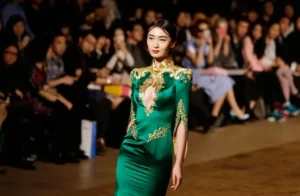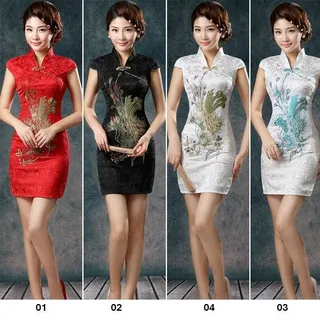Chinese women’s fashion has evolved significantly over the years, blending traditional elements with modern styles to create a unique aesthetic. Whether it’s the iconic qipao or modern urban streetwear, Chinese women’s fashion offers a rich mix of cultural heritage and contemporary influences. If you’re looking to explore what Chinese women’s fashion looks like today and how it’s making waves internationally, this article will break it all down for you.

The Foundation: Traditional Chinese Clothing
When we think of Chinese women’s fashion, traditional garments like the qipao (also known as cheongsam) and the hanfu immediately come to mind. These clothing items are more than just dresses—they carry deep cultural significance.
- Qipao (Cheongsam): The qipao is a one-piece dress that hugs the body and features a high neckline with a slit along one side. It first became popular in the 1920s in Shanghai and has since become a symbol of Chinese women’s fashion elegance. It’s known for its intricate patterns, often inspired by nature, such as flowers or birds. Today, the qipao has undergone several modern adaptations, making it more fitted and suited for contemporary fashion. It’s still worn at formal occasions like weddings, festivals, or fashion events, but many modern designers have added a contemporary flair with bold colors and patterns.
- Hanfu: Another traditional garment, hanfu, is rooted in ancient Chinese history, dating back thousands of years. It’s characterized by wide sleeves, long robes, and intricate details. Today, there’s a growing movement among younger Chinese women to revive hanfu as casual wear, reimagining it with modern fabrics and styling.
The Rise of Streetwear and Modern Fashion
Chinese women’s fashion is not limited to traditional styles. The rise of modern streetwear in China has become an integral part of youth culture. Global fashion trends are being reinterpreted through the lens of Chinese sensibilities. With the rise of urbanization, Chinese cities, especially places like Shanghai and Beijing, have become fashion hubs where global and local brands coexist.
- Street Style: From oversized blazers to high-waisted jeans, Chinese street fashion has a unique twist. The influence of global brands is evident, but local designers are mixing it up by incorporating subtle cultural motifs. Bold colors, playful accessories, and creative layering are the cornerstones of this modern Chinese style. Additionally, Chinese women’s fashion often blends high fashion with casual elements, making it both stylish and practical.
- Sustainability and Minimalism: Many Chinese women are also turning towards more sustainable fashion choices, embracing minimalism in their wardrobe. Simple, clean lines and neutral colors dominate this trend, reflecting a desire for functionality while maintaining an aesthetic appeal. This minimalistic approach also ties into the growing interest in eco-conscious fashion choices.
The Influence of Western Fashion
It’s impossible to talk about Chinese women’s fashion without acknowledging the influence of Western Chinese women’s fashion trends. The global nature of fashion means that Chinese designers are constantly adapting and reinterpreting Western styles to fit the Chinese market. However, they often incorporate traditional Chinese elements to make these styles their own. Western brands like Chanel, Gucci, and Louis Vuitton have a strong presence in China, but local designers are increasingly gaining popularity, offering a unique take on global trends.
Chinese Fashion in the Global Market
Chinese designers have made a significant mark on the global fashion scene. Designers like Guo Pei, known for her intricate couture gowns, and Uma Wang, famous for her fusion of Eastern and Western aesthetics, are gaining international acclaim. Their designs often feature traditional Chinese embroidery techniques and fabrics, bringing a fresh perspective to the global Chinese women’s fashion landscape.
- Celebrity Influence: Many Chinese celebrities and influencers play a massive role in shaping fashion trends both locally and globally. Celebrities like Fan Bingbing, for example, have brought Chinese fashion to the international stage, often showcasing both traditional and modern outfits at events like the Cannes Film Festival.
- E-commerce and Social Media: China’s e-commerce platforms, such as Taobao and JD.com, have also transformed the fashion landscape. Social media influencers and live-streaming platforms are driving the sale of fashion items, and trends can go viral within hours. For instance, “Guochao,” which means “national wave,” is a trend where traditional Chinese designs and symbols are combined with modern streetwear, and it has gained significant popularity both in China and globally.
How to Incorporate Chinese Fashion into Your Wardrobe
If you’re curious about how to integrate elements of Chinese fashion into your wardrobe, here are a few tips:
- Start with a Qipao-inspired Dress: Opt for a modern version of the qipao that’s more fitted and suitable for casual occasions. It’s a perfect mix of tradition and style.
- Add Embroidered Pieces: Chinese fashion often incorporates intricate embroidery. Whether it’s a blouse, a jacket, or even accessories, embroidery can give your outfit a unique flair.
- Play with Silhouettes: Traditional Chinese garments like the hanfu offer a different take on clothing silhouettes. You can try out wide sleeves or long, flowing skirts for an elegant look.
- Mix and Match: The beauty of Chinese fashion today is its versatility. You can pair traditional pieces with Western-style items to create a fusion look that’s both unique and stylish.

FAQs
Q: What are the most popular traditional Chinese garments? A: The qipao (cheongsam) and hanfu are two of the most iconic traditional Chinese garments for women.
Q: Is Chinese fashion influenced by Western trends? A: Yes, Chinese fashion blends traditional elements with Western fashion, particularly in streetwear and modern fashion trends.
Q: How can I incorporate Chinese fashion into my wardrobe? A: Start with a modern qipao, add embroidered pieces, or experiment with wide silhouettes inspired by traditional Chinese clothing.
Q: Is sustainability a trend in Chinese fashion? A: Yes, many Chinese women are adopting sustainable and minimalistic fashion, focusing on eco-conscious choices and simple designs.
Conclusion
Chinese women’s fashion is a dynamic blend of tradition and modernity. Whether you’re drawn to the elegance of the qipao, the historical significance of hanfu, or the bold creativity of streetwear, Chinese fashion offers something for everyone. With its increasing global influence and the rise of local designers, Chinese women’s fashion is becoming a significant force in the fashion world. Embrace the diversity, experiment with styles, and find ways to integrate the rich culture of Chinese fashion into your wardrobe.
Read more: womenfashionwear.site

